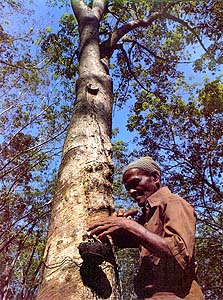 |
| Rubber Tapper
|
Before the invention of synthetic rubber, natural rubber used to be one of the major cash crops for countries in South East Asia, Africa, and South America. In Sri Lanka it still is, thanks to improvements is growing methods and innovative marketing techniques. To see a line of rubber tappers, walking along a country road in the morning is still not a rare sight. Latex (the thick white sap of the rubber tree) is collected by cutting a helical groove in the bark of the tree using a specially designed knife. Care has to be taken to ensure that the cut is deep enough to extract the maximum amount of latex, yet without damaging the tree. Latex is usually collected in small tin cups attached to the bottom end of the groove. An experienced tapper can handle up to four hundred trees in a day.
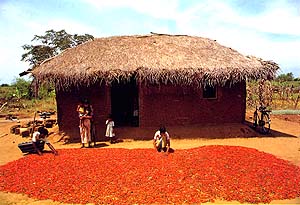 |
| Hot Peppers Drying in the Sun
|
The dry northern plains of Sri Lanka is blessed with ideal climate for growing may varieties of crops. The hot day-time temperatures and dry air make it specially suitable for vegetables like chilli (hot pepper) and onions. Looks like the owner of this small farm certainly had his share of good luck with his crop, looking at this red carpet of chilli peppers drying in the hot sun.
The small home in the background is made totally from locally available building materials. The adobe walls, and the roof made of woven coconut fronds bear witness to the ingenuity of the simple village folk.
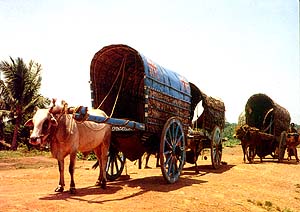 |
| Bullock Cart
|
Favorite mode of transport of goods and people during the early part of the century, bullock carts survived the advent of machine age, and thank you very much, doing quite well even today. Still the least polluting, and with no burden on the natural resources, except perhaps for a bundle of hay every day, these wagons drawn by one or two bulls hold the romance of village life in tact. In Sri Lanka, there is a whole facet of poetry (karattha kavi - poems of the cart) devoted to songs sung, and poems recited by the drivers of these carts, to keep awake during the lonely drives, for most part bullock carts were driven at night to avoid the heat of the day.
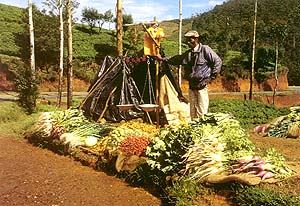 |
| Direct from the garden to the stall by the road |
How fresh do you like your Pathola, Karawila, Boanchi, and Brinjals (snake gourd, bitter melon, beans and egg plants) today?. Like to pick it yourself straight from this small farmers back yard?. Due to a short lived, but highly effective import embargo in the 70's of some essential products, including some food items, the average Sri Lankan turned to farming and even after the embargo was lifted kept his green thumbs intact and working hard. Now-a-days scenes like these, where villagers are selling common every day vegetables, like beans and egg plants and more exotic fruits like Mangosteen, Durian and Rambotan, are unavoidable for the visitor to the countryside.
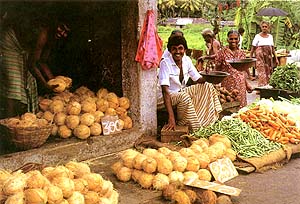 |
| A typical village stall
|
This is a picture of a typical,
pola - country market, that can be found anywhere in Sri Lanka. Although mom and pop groceries, and supermarkets are making strong inroads, the village
pola still holds a nostalgic foothold in the Sri Lankan life. Here, the busy house-wife on her way back home in the evening from her job in the office, can still get her fresh coconut for the evening meal, without having to stand in line to pay for it. And if you just don't happen to have the cash to pay for it today, it is alright too. Not to worry !. You will be there tomorrow too - it is almost a family affair!.

No comments:
Post a Comment